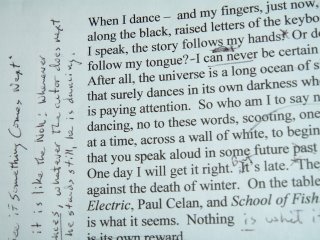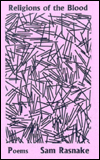Wholeness as Possibility: An Art of the Body
A dusting of snow starts my morning – coffee and a book. Startling music of the lines. A dark and beautiful texture of language. The physicality of a life/body – the smeared mess of it – mingling with another.
* * *
Ma-tsu, an 8th century, a.d., Ch’an master, once asked a student (Pai-chang) to explain the actions of a flock of wild geese in the sky. The student replied that the geese were flying away from him – a typical human response. Correcting the student with a whack to the head, Ma-tsu emphasized that the geese weren’t flying away from anything, but were flying into their own existence. This example is quite appropriate, when considering the poetry of Eileen Tabios, a Filipino, now residing in California, and winner of, among other honors, the Phillippines’ National Book Award for Poetry and the Pen/Oakland Josephine Miles National Literary Award. Her mammoth work I Take Thee, English, for My Beloved (Marsh Hawk, 2005) is a strong gathering of many forms that expresses her serious theme: escape. Her version, like Ma-tsu’s teaching on the flight of geese, is more focused on escape into than escape from. Escape, as theme, is deftly illustrated by the trope of flight. This gives the work, despite its size of five hundred pages, a weightless quality – in terms of possibilities.
The book’s layout in five major sections and numerous subsections was both appealing and challenging to me. I should add that the main sections – and many subsections – are, in effect, collections unto themselves, more than able to stand on their own; yet, all function harmoniously as part of the whole. My initial response was that I was at the beginning of a great journey,
 and that expectation has been rewarded. Tabios’ writing style strikes me as varied and reader friendly; also, the recurrence of specific imagery and language, while adding resonance and depth to the beauty of this work, is haunting.
and that expectation has been rewarded. Tabios’ writing style strikes me as varied and reader friendly; also, the recurrence of specific imagery and language, while adding resonance and depth to the beauty of this work, is haunting.As a poet, Tabios is witty and provoking. This collection, while experimental, is universal in its detailed expression of a very personal and private world, to which Tabios gives the reader access. The book’s numerous forms include memoir, hay(na)ku, prose poem, play, couplet variation, story, footnote, and draft-form showing corrections. The premise of the book is an unusual ceremony that has its full and unusual expression in the notion of “Poetry as a way of life”. Tabios’ approach to this “way of life” lends fiction-like qualities to the collection, creating groups of story-pieces that function as a novel.
* * *
A reading of one poem
"Hair"
– from "The Definitive History of Fallen Angels: An Autobiography,"
I Take Thee, English, for My Beloved
The myth of Pygmalion, interestingly enough, is the background, and foreground, for the poem “Hair” (p. 285). As background, the reader notes that, like the myth, Tabios' poem is focused on the creative process of writing and the writer's life, but also gives specific shape to a major thematic focus for the whole of I Take Thee English. In the grandest sense, this is a poem about self-discovery. Two important details of the myth serve Tabios: Pygmalion's physical work on the statue and the statue's transformation, by the gods, to a woman – Galatea. Combining these two details, somehow, makes the artist a complete person. A wholeness is possible because of this process of making art and its end result.
Most fascinating to me is the poem’s shift from a notion of an absence of betrayal and disillusionment – associated in the poem by their absence, making their effect all the more real – to the physical act of kissing both “the stumps of my [the poem’s narrator] fresh wings” and the “tears to sunlit blue.” The poem moves from the very inward void where disillusionment once dominated to an opening into something unknown but wonderful – into the possibility of life itself.
Tabios’ writing in this archetypal and erotically charged piece – written in tight couplets, the dominant form of this section of the book – compels the reader to an empathetic experience of the poem’s world. This makes the reader feel, deliciously, as if some secret, personal view is unfolding: the creative act of a work of art in progress. She has selected Pygmalion as – on some level – the poet’s alter ego. This alter ego, however, shouldn’t be limited to another version of Tabios, the woman; in addition, I read the Pygmalion character as the alter ego of Tabios, the poet.
Tabios creates a distorted but commanding nuance in fusing the artist with the art / the poet with the poem. She writes,
Fortunately, Pygmalion will never
become disillusioned with my hair.
I never betrayed girlhood with
cruelty, using whispers as daggers.
On the surface, the poetry reveals the limitations and fragility of human beauty and a life (Galatea’s) thrown full-force into adulthood. Beneath, this is a poem about writing, about transformation. Pygmalion – as artist and stand-in poet – morphs, in the poem’s opening lines, into the crafted work of stone changed, by the gods, into a real woman. The poet’s becoming the poem is actualized in the breath and voice of the lines. The poem’s reference to hair as title and as created/real image surely draws from its archetypal function as source for both beauty and power.
In the poem’s middle lines, the image of transformation is given a poignant edge. The created statue-woman – and I must add that Tabios’ intention is the self-made artist/poet – comes to realize that the artistic passion cools in concert with the cool-down of relationships. She writes that “time // consistently kills passion.” The marvelous word choice of “consistently” reveals, with a quiet but economic strength, the many lessons that are learned. And here one should recognize the idea of lessons learned as the other side of the many relationships: both human and artistic (artist and art / poet and poem ).
The trope of flight is certainly realized in the angelic figure with “stumps of … wings” who falls – an image-thread that permeates the entire collection. The fall, with its emotional, physical, and spiritual intent, reinforces the relationship of Pygmalion and the statue (Galatea, Greek for “sleeping love”). As Pygmalion’s act of sculpting has become the finished work of statue and “sleeping love,” Tabios’ act of writing has changed, also, into a finished work of poet and woman. Oddly enough, the result of Pygmalion and Galatea’s sexual union is the birth of Metharme, whose name, according to Robert Graves, means “change”. The surrender of the poet to the poem – like the poem’s central figure of Pygmalion who surrenders to his art – is given a sexual resonance. The narrator speaks of the tension between desire and control:
a discourse that makes me want
to tear off my clothes so I can
surround you – quite a difference
from you penetrating.
Tabios, remarkably, declares that the twisting of words determines the “Pathos”. The pity engendered in the reader informs the many possible meanings of a fall as metaphor: spiritual (the damning of the you and me of the poem), physical (the motion, bird-like – a recurring image for the book – in space), and erotic (the corporeal act of seduction).
With a jolt, Tabios reveals the poem’s nerve center in lines that become all the more impacting because they are spoken in the poem, establishing an erotic current to the notion of self-discovery:
“My head bends, my mouth touches
my breasts, my lips taste a spot
of milk on thickening brown nipples.”
Love, yes, “is not about going back
but moving toward something.”
If one follows the poem’s logic in the combination of artist and art (Pygmalion and Galatea), making one complete person, the next recognition is an easy one: the poet and poem becoming a complete work, a whole. This wholeness of poet and poem – and here is the paradox – will never be understood separately, but only in the link that is made between the two.
The marvel of “Hair” – Pygmalion and Galatea, poet and poem, poem and reader – is the connection of variant sources that meet in a place beyond the page. This is a remarkable achievement, yet is typical of the poetry found in I Take Thee, English, for My Beloved. Tabios’ writing is fresh and doesn’t disappoint.
[This review later appeared at Blue Fifth Review.]









No comments:
Post a Comment